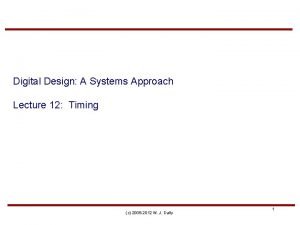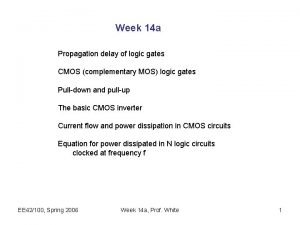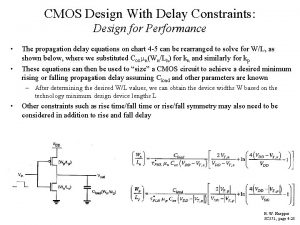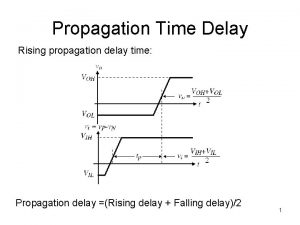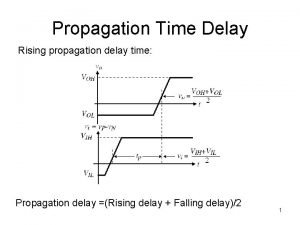Linear Delay Model In general the propagation delay




- Slides: 4

Linear Delay Model • In general the propagation delay of a gate can be written as: d = f +p – p is the delay due to intrinsic capacitance. – f is the effort delay or stage effort and depends on the complexity and fanout of the gate. • The stage effort is: f = gh with the complexity represented by the logical effort g. • An inverter is defined to have a logical effort of 1. • More complex gates have greater logical effort indicating that they take longer to drive a given fanout. • A gate driving h identical copies of itself is said to have an electrical effort or fanout of h. • The electrical effort of nonidentical copies of the gate or any type of load is compounded to be h =Cout/Cin.

Logical Effort • Logical effort of a gate is defined as the ratio of the input capacitance of the gate to the input capacitance of an inverter that can deliver the same output current. • Assuming that the p. MOS has twice the resistance of an n. MOS we have Cin(inv) = 3 for inverter that achieves symmetric switching. • The logical effort of an inverter is: g =3/3 =1. • How well can we design a NAND or NOR gate to give the output current equal to that of a unit inverter? • NAND: Cin for unit inverter is 3 units while that of the NAND is 4 units for each input. • Logical effort for NAND is 4/3. • The NOR gate has Cin of 5 units and thus has a logical effort of 5/3. Determine the logical effort of a 3 -input NAND

Parasitic Delay • The parasitic delay of a gate is the delay of a gate when it drives zero load. • A quick estimation of parasitic delay computations only accounts for the diffusion capacitance of the output node. • The inverter has 3 units of diffusion capacitance on the output with each transistor having resistance R. • Its parasitic delay becomes 3 RC • The normalized parasitic delay of an inverter is 1 and will be referenced as pinv. • pinv is the ratio of the output capacitance to the input capacitance. • The parasitic delays of the NAND and NOR gates is twice that of the inverter (2 pinv), because they each have 6 units of diffusion capacitance. • Note that internal node capacitances have been ignored.

The Elmore Model • Parasitic delay grows more than linearly with an increase in the number of inputs in a real NAND or NOR circuit. • tpd =R(3 n. C)+Sumn 1 (i. R/n)(n. C)=(n 2/2+5 n/2)RC i=1 • In practice it is advisable to keep n=4 as seen that tpd grows quadratically with n. • Series n-type devices are better than series p-type devices. Why? • The linear model does not account for the slopes of the input and output signals (assumes zero rise and fall times). • The input arrival times is not accounted for. The inputs do not simultaneously switch ON and OFF.
